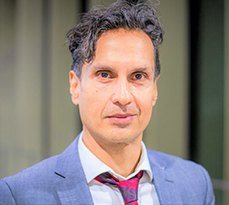How key workers go unrecognised but are the hidden part that holds up an “iceberg”.
The coronavirus pandemic has expanded the common perception of who is a “key” worker to include not only doctors and pharmacists but also, cleaners, janitors and other unsung heroes of the past few months.

A new paper by Shahzad (Shaz) Ansari, Professor of Strategy & Innovation at Cambridge Judge Business School, argues that such seemingly mundane activities are the hidden work that undergird more visible institutions, leaders and innovators.
Specifically, the article focuses on “invisibilities,” or unspectacular institutional processes, and introduces the idea that institutional work is an “iceberg” that involves interplay between its visible and invisible, undergirding parts. The paper discusses the role of “invisible elbows” – the unnoticed interactions of people who perform mundane but essential enabling tasks in our society.
At the same time, the paper concludes that the very invisibility of such work also ensures that their role in the maintenance of institutions such as health standards is under-valued and not adequately recognised, which unfortunately contributes to the marginalisation and even the stigmatisation of some of these occupations.
The research paper, “From ‘invisible elbows’ to icebergs: rethinking the invisible and mundane institutional processes” – is co-authored by Dr Adriana Mica and Dr Mikołaj Pawlak from the University of Warsaw.
We asked Shaz Ansari to talk about some of the paper’s findings and conclusions:
Please explain why the “iceberg” metaphor fits the recent redefinition, in many minds, of who is a “key worker”?
Usually, we do not see the everyday toil behind well-functioning institutions. Or we just see their most visible representatives and leaders. We thus see the mayor of the city, but not the cleaners who collect garbage. We know the surgeon, but not the nurses and cleaners who keep the hospital disinfected. Organisations and broader social institutions operate and are sustained not least thanks to the collective effort of many social actors – who clean residential homes, care for children and the elderly, and drive ambulances.
Yet we take it for granted that things work and the world goes round, and we do not notice nor adequately recognise and reward their efforts. That is why we use the metaphors of invisible elbows and visible icebergs. Many aspects of human action crucial for sustaining institutions are below the water (the hidden part of an iceberg); we usually do not pay attention or pretend that these roles are less important or of less value because they are “mundane”.
How do people who perform these “mundane” tasks, as your paper says, actually set standards in areas of health and safety?
The standards in areas of health and safety simply cannot be achieved without the collective effort of people performing these everyday tasks of cleaning and keeping places safe. The standards of health and safety are maintained not just by the levels set by regulatory bodies but also by human actions that materialise them. The standards are what we pay attention to, and this is what allows us to evaluate the quality of institutions such as hospitals. It may sound banal, but the real issue is that in “normal” times we tend to forget how everyday maintenance is achieved and we treat standards as evaluation processes of the quality of work that we take for granted.
Why do you think it took a global crisis for the world to recognise the contributions of people who perform these unsung tasks?
Very often unprecedented events and disruptions may reveal what we usually take for granted. We started working on the invisible elbows and visible icebergs paper before the COVID-19 pandemic, but the crisis brought it into sharper focus. A crisis is a situation that derails us from our routines and allows as to see things differently and it opened our eyes to all these essential tasks.
The idea of “invisible elbows” has been around since the mid-1990s in organisational studies. Why do you think it’s so relevant to the current global situation?
There is an increasing acknowledgement that institutions exist thanks to millions of invisible elbows, the unnoticed interactions which constitute the fabric of our organisations and societies. We are used to noticing visible hands – actions of leaders – but they are only made possible by these invisible elbows.
What can society do further to make sure that the role of these newly identified key workers is properly recognised?
As researchers, we cannot focus solely on the easily visible and spectacular instances of institutional work. It’s a common trap because our culture uses narrative tools to tell the stories built around the conflict between heroic antagonists and protagonists. Yet, in real life, the achievements of great leaders, innovators, and other prominent figures involve the collective efforts of many unsung heroes.


